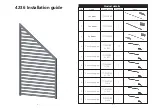
Sonication
fl
uid
Insert basket
Contact
fl
uid
Sonication
fl
uid
Inset beaker
15 / 36
1566g GB/2019-02
1
electronic GmbH & Co. KG • Heinrichstraße 3-4 • 12207 Berlin • Deutschland • [email protected]
4 Use
Direct sonication
Normally, sonication takes place
directly
in the oscillating tank. For this
purpose, the objects to be treated are placed in a basket and hung inside the
oscillating tank which is
fi
lled with sonication
fl
uid.
Indirect sonication
Indirect
sonication in inset beakers is to be conducted for special
applications or to protect the stainless steel oscillating tank in the case of:
- Sonication of sample
fl
uids.
- Use of chemically aggressive
fl
uids (e.g. using acids as cleaning agents).
- Removal of chemically aggressive soiling (e.g. cleaning of developing
machine racks).
- Removal of abrasive contamination (e.g. polishing pastes, quartz, sand).
For indirect sonication, a contact liquid (water + surfactants) must be
fi
lled in
between the inset beaker and the oscillating tank.
4.1
Instructions for use
Instructions -
fi
lling
• For ultrasonic baths with outlet, verify that the ball valve is closed.
• Ultrasound and heating must be turned off.
• Do not
fi
ll ultrasonic tank with hot water. Maximum
fi
lling temperature: 50 °C.
• At least drinking-quality water must be used to
fi
ll the oscillating tank.
• Water without additives is not suited for sonication. BANDELIN recommends the TICKOPUR or
STAMMOPUR preparations.
• Only use distilled or deionised water without additives in inset beakers or insert tubs.
• The
fi
ll level must always be at or slightly above the
fi
lling level mark.
A low
fi
ll level will damage the ultrasonic bath!
• Do not use any combustible, explosive, non-aqueous liquids or azeotropic mixtures directly in
the stainless steel oscillating tank (e.g. benzine, solvents). Furthermore, chemicals that contain
or that separate chloride ions (some disinfectants, household cleaners, and dish detergents),
may not be used directly in the stainless steel tank.
• When working with aggressive preparations in inset beakers or insert tubs: Prevent the contact
liquid or stainless steel surfaces from being sprayed. If necessary, replace the contact liquid,
clean the surfaces and wipe dry.
• When using strongly acidic preparations, the hard chromium plating of the ball valve may
become corroded and the ball valve start to leak.
If the use of a strongly acidic cleaning agent cannot be avoided, the use of a stainless steel ball
valve is recommended.
• When using preparations, the safety instructions included in the product lea
fl
ets are to be
fundamentally adhered to.
• Replace used sonication
fl
uids, do not refresh by adding
fl
uids.
















































